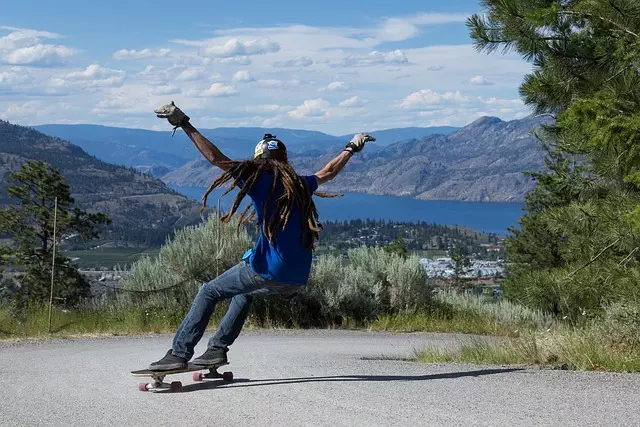For beginners embarking on downhill longboarding, it's crucial to prioritize safety with comprehensive protective gear. Understanding your longboard's components and mastering skills like foot braking, weight distribution, carving, and proper stance will help you navigate slopes confidently. Choose a safe location with smooth pavement, gradual inclines, clear sightlines, and legal permission for longboarding. Ensure your longboard is well-maintained with a sturdy deck, tight trucks, and good grip tape to prevent accidents. Always ride within your comfort zone, practice consistently, and be aware of weather conditions that can affect your ride. With these considerations in mind, beginners can enjoy the thrill of downhill longboarding while minimizing risks and enhancing their experience.
Embark on the exhilarating sport of downhill longboarding with our comprehensive guide tailored for beginners. Whether you’re drawn to the thrill of speed or the allure of conquering steep slopes, this article will equip you with the knowledge to select your ideal beginner-friendly longboard, the safety gear necessary for protection, and the mastery of essential techniques. From choosing the right location to maintaining your board in peak condition, learn how to navigate each aspect of downhill riding safely and effectively. Join us as we explore the world of downhill longboarding, where adrenaline meets precision, and every ride is a journey.
Understanding the Basics of Downhill Longboarding for Beginners

Downhill longboarding is an exhilarating sport that requires a combination of skill, speed, and safety awareness. For those new to the activity, selecting the right longboard for beginners is the first step towards a safe and enjoyable experience. A longboard designed for downhill riding typically features a sturdy deck, high-quality trucks with stable geometry, and wheels that can handle high speeds and maintain grip on various surfaces. The wheel size and durometer play crucial roles in the stability and speed of the board; beginners should opt for larger wheels with a higher durometer to ensure both speed control and a smooth ride. Additionally, understanding the body positioning and weight distribution is vital for maintaining balance and control during descents. Beginners should practice the proper foot placement and learn how to effectively use their center of gravity to navigate turns and straightaways confidently. Proper protective gear, including a helmet, knee pads, elbow pads, and gloves, is non-negotiable as it can greatly reduce the risk of injury in case of falls or collisions. As you progress, gradually increase your speed and experience downhill slopes of varying steepness. It’s important to start with gentle inclines to build confidence and skill before attempting steeper, more technical runs. Always prioritize safety, practice regularly, and seek guidance from experienced riders or professional instructors to refine your technique and gain a deeper understanding of the sport’s nuances.
Key Features to Look for in a Beginner-Friendly Longboard for Downhill Riding

When selecting a longboard for beginners who are interested in downhill riding, it’s crucial to focus on features that promote stability, control, and safety while allowing room for skill development. A longboard designed for downhill riding should have a sturdy construction with a robust deck that can handle the forces involved at high speeds. The deck size is also an important consideration; a longer and slightly wider deck offers more foot space, which is beneficial for beginners to find their balance and stance comfortably.
The wheel setup is another key factor. Beginner-friendly Longboards typically come with larger wheels, ranging from 65mm to 75mm in diameter, which provide better roll and grip on various surfaces. A harder durometer, around 78a to 85a, ensures that the wheels can handle the stress of downhill riding while maintaining enough traction to prevent slides during tight turns. Additionally, the wheel’s bearing quality should not be overlooked; high-speed bearings will perform better and last longer under the demands of downhill riding. A good longboard for beginners will also feature a reliable truck system with a responsive turning ratio, ensuring that the rider can maneuver effectively without feeling overpowered. Lastly, ensure the longboard has quality brakes that are easy to modulate, allowing beginners to control their speed efficiently and safely as they navigate downhill slopes.
Top Longboards for Downhill Riding: A Beginner's Guide to Selection

When venturing into the realm of downhill longboarding, selecting the right board is paramount for a beginner to ensure safety and enjoyment. A longboard designed for downhill riding will have characteristics that provide stability at high speeds and respond well to aggressive carving. As a newcomer, it’s advisable to opt for a longboard with a sturdy construction and a reliable trucks and wheel setup to handle the forces encountered in downhill racing. Longboards with symmetrical shapes, like drop-through or top-mount designs, offer versatility for both downhill bombing and commuting. They also tend to have larger wheels that are better at absorbing the impact of rough terrain and maintaining momentum on long runs. For beginners, a board with a concave deck design can enhance foot positioning and provide additional control during sharp turns. Additionally, consider a longboard with a moderate wheelbase, which offers a balance between stability and maneuverability for those still mastering their technique. Features like high-rebound bushings and ABEC-rated bearings contribute to a smoother ride and can be found on models tailored for beginners. By choosing a longboard that aligns with these criteria, novices can confidently take their first steps into the thrilling world of downhill riding. Always remember to wear protective gear, including a helmet, knee pads, and elbow pads, to ensure your safety as you progress in this exciting sport.
Safety Gear: Essential Protective Equipment for Downhill Longboarders

When pursuing downhill longboarding, safety should be paramount, especially when using a longboard designed for beginners. The high speeds and intense forces involved in downhill riding necessitate robust protective equipment to safeguard riders from potential impacts and injuries. A helmet is the most critical piece of gear, offering head protection against low- and high-impact incidents. Full-body padding, including knee, elbow, and shoulder pads, is designed to absorb impacts and reduce abrasion. Additionally, wrist guards protect the delicate joints that could be easily sprained or broken in a fall. Properly fitting gloves can further enhance protection by providing a firm grip on the board while shielding hands from road rash.
For beginners venturing into downhill longboarding, it’s crucial to invest in gear specifically tailored for this extreme sport. Quality gear not only protects but also instills confidence, allowing riders to focus on technique rather than fear of injury. Chest protectors and a sturdy pair of shoes or boots with good ankle support complete the ensemble, ensuring that every part of the body is defended against the rigors of downhill riding. It’s also advisable to wear brightly colored clothing to enhance visibility on the road, particularly during early morning or late evening rides. With the right protective equipment in place, beginners can embark on their downhill longboarding journey with a greater degree of safety and enjoyment.
Mastering the Techniques: Tips for Controlling Speed and Navigating on a Longboard

When venturing into downhill longboarding, mastering speed control and effective navigation are key to a safe and exhilarating experience. For beginners, it’s crucial to start with an understanding of the longboard’s components, including the trucks, wheels, and bearings, as these directly influence your ride. To control speed on a longboard, especially when going downhill, employ the ‘foot braking’ technique by dragging the toe of your front foot against the ground while maintaining balance. This method is more effective than dragging your heel, which can cause wheel bite and loss of control. Additionally, learn to shift your weight forward or backward to either gain or slow down speed smoothly.
Navigating on a longboard requires a combination of body positioning and footwork. Beginners should practice carving – a motion where you turn the board by shifting your weight and moving your feet – to effectively navigate corners and maintain speed. Keep your knees bent and your arms out for stability. As you become more comfortable, incorporate proper foot placement, with your back foot closer to the tail for breaking and your front foot over the bolts for turning. By practicing these techniques in a controlled environment, such as a gentle slope, you’ll build the confidence and skill needed for tackling steeper hills. Remember to always wear protective gear and never ride beyond your comfort level or ability. With consistent practice and adherence to safety precautions, longboarding for beginners can become an exhilarating downhill experience.
Choosing the Right Location: Factors to Consider When Selecting a Downhill Riding Spot

When selecting a location for downhill longboarding, especially for beginners, it’s crucial to assess various factors that ensure both safety and an enjoyable experience. The ideal spot should feature a long, winding road with minimal vehicle traffic to provide a safe environment for riders to practice their skills without the risk of sudden collisions. A smooth pavement surface is essential to avoid wheel bite and to maintain speed and control. Beginners should look for gradual inclines that allow them to get accustomed to the feeling of high-speed descents without being overwhelmed. The length of the hill can impact the entire experience; a hill that’s too long might be daunting for a novice, whereas one that’s too short may not provide enough momentum for a satisfying ride.
Additionally, the surrounding environment plays a significant role in the overall experience. Accessibility to medical facilities and proximity to support services can be vital in case of an emergency. Clear visibility of the path ahead is also important, as it enables riders to anticipate and navigate potential obstacles or sharp corners. Weather conditions should be considered; longboarders prefer calm, dry weather that won’t compromise grip or visibility. Lastly, local regulations and the legality of downhill longboarding in the area must be verified to avoid any legal complications. By carefully evaluating these factors, beginners can find a suitable downhill riding spot that will help them progress safely and effectively.
Maintenance and Care: Keeping Your Longboard in Optimal Condition for Downhill Rides

To ensure your longboard is ready to tackle the steepest slopes and provide a safe and exhilarating downhill riding experience, regular maintenance and meticulous care are paramount. For those using a longboard designed for beginners, understanding the fundamental aspects of maintenance will extend the lifespan of your board and enhance performance. The trucks, which provide the flexibility needed to navigate tight corners at high speeds, should be regularly inspected for any signs of looseness or excessive wear. Ensure they are tightened to the manufacturer’s recommended specifications to maintain responsiveness and control.
Wheels and bearings are critical components that significantly affect your ride quality. Softer wheels are often preferred for downhill riding as they offer better grip, but their durometer should be matched to the surface you’ll be riding on. Check your bearings for any debris or dirt that may impede smooth rolling; clean them thoroughly and lubricate with a high-quality bearing lube to ensure optimal speed and minimal friction. Bear in mind that bearings should be replaced periodically, as their performance degrades over time, which can affect both your speed and the longevity of your ride. Additionally, the deck itself should be checked for cracks or delamination; any structural damage can compromise stability and safety. Regularly applying a high-quality deck wax or grip tape traction enhancer will keep your feet securely on the board, even during fast downhill runs. Remember to tune up your longboard with these maintenance tips, especially if you’re new to downhill riding, to ensure an optimal experience and to avoid potential accidents caused by equipment failure.
